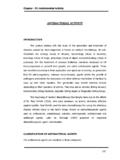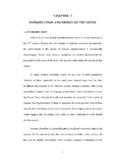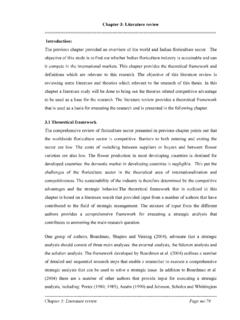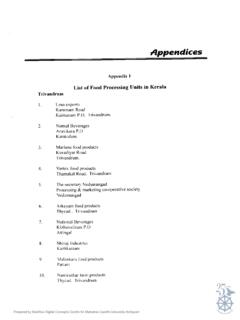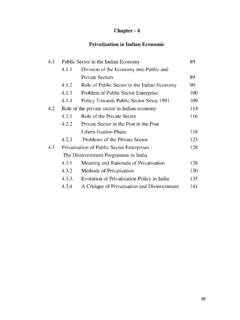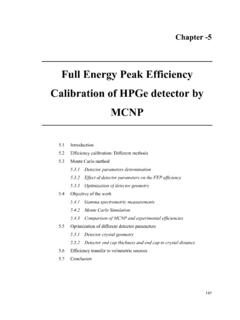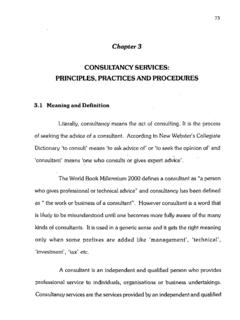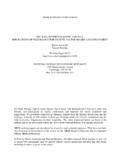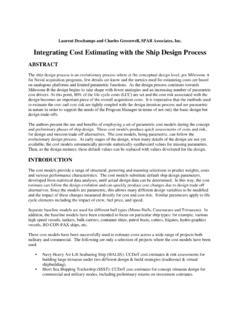Transcription of CHAPTER 3 PRODUCTIVITY IMPROVEMENT …
1 CHAPTER 3 PRODUCTIVITY IMPROVEMENT TECHNIQUES AND IT S RELATIONSHIP WITH WORK STUDY Title Page No. Introduction 69 PRODUCTIVITY and PRODUCTIVITY IMPROVEMENT : Concept 69 Importance of Higher or Improved PRODUCTIVITY 74 Factors of PRODUCTIVITY IMPROVEMENT 76 Some Techniques for Measurement of PRODUCTIVITY IMPROVEMENT 76 PRODUCTIVITY IMPROVEMENT Indices 78 Japanese PRODUCTIVITY IMPROVEMENT Techniques 80 Work Study as a PRODUCTIVITY IMPROVEMENT technique 84 Techniques of Work Study 87 Basic Procedure of Work Study 87 Work Measurement Techniques for PRODUCTIVITY IMPROVEMENT 88 Meaning and objectives of Work Measurement 88 Basic procedure of Work Measurement 90 Techniques of Work Measurement 90 Techniques of Work Study and their Relationship with PRODUCTIVITY IMPROVEMENT 96 69
2 CHAPTER 3 PRODUCTIVITY IMPROVEMENT TECHNIQUES AND IT S RELATIONSHIP WITH WORK STUDY Introduction: PRODUCTIVITY IMPROVEMENT is to do the right things better and make it a part of continuous process. Therefore it is important to adopt efficient PRODUCTIVITY IMPROVEMENT technique so as to ensure individuals and organization s growth in PRODUCTIVITY . The aim of this CHAPTER is to introduce and understand PRODUCTIVITY IMPROVEMENT , various techniques of PRODUCTIVITY IMPROVEMENT , work study and its relation with PRODUCTIVITY IMPROVEMENT . To achieve this present CHAPTER is arranged as follows: Introduction PRODUCTIVITY and PRODUCTIVITY IMPROVEMENT : Concept Importance of Higher or Improved PRODUCTIVITY Factors of PRODUCTIVITY IMPROVEMENT Some Techniques for Measurement of PRODUCTIVITY IMPROVEMENT Factor PRODUCTIVITY Indices Japanese PRODUCTIVITY IMPROVEMENT Techniques Work Study as a PRODUCTIVITY IMPROVEMENT technique Work Measurement Techniques for PRODUCTIVITY IMPROVEMENT Techniques of Work Study and their Relationship with PRODUCTIVITY IMPROVEMENT PRODUCTIVITY and PRODUCTIVITY IMPROVEMENT : Concept PRODUCTIVITY is the ratio between output and input.
3 It is quantitative relationship between what we produce and what we have spent to produce. 70 PRODUCTIVITY is nothing but reduction in wastage of resources like men, material, machine, time, space, capital etc. It can be expressed as human efforts to produce more and more with less and less inputs of resources so that there will be maximum distribution of benefits among maximum number of people. PRODUCTIVITY denotes relationship between output and one or all associated inputs. European PRODUCTIVITY Council states that PRODUCTIVITY is an attitude of mind. It is a mentality of progress of the constant IMPROVEMENT of that which exists.
4 It is certainty of being able to do better than yesterday and continuously. It is constant adoption of economic and social life to changing conditions. It is continual effort to apply new techniques and methods. It is faith in human progress . In the words of Peter Drucker PRODUCTIVITY means a balance between all factors of production that will give the maximum output with the smallest effort1. On the other hand, according to International Labour Organisation PRODUCTIVITY is the ratio between the volume of output as measured by production indicates and the corresponding volume of labour input' as measured by production indices and the corresponding volume of labour input as measured by employment indices2.
5 This definition applies to an enterprise, industry or an economy as a whole. The PRODUCTIVITY of a certain set of resources (input) is therefore the amount of goods or services (output) which is produced by them. Land and building materials, machines, manpower (labour), technology etc. are the resources at the disposal of a manufacturing company. Therefore higher (improved) PRODUCTIVITY means that more is produced with the same expenditure of resource at the same cost in terms of land, materials, machine, time or labour, alternatively, it means same amount is produced at less cost in terms of land, materials, machine time or labour that is utilized.
6 In countries where capital and skill are short, while unskilled labour is plentiful and poorly paid, it is especially important that higher PRODUCTIVITY (improved) should be looked for by increasing the output per machine or piece of plant or per skilled worker. Improving PRODUCTIVITY means increasing or raising PRODUCTIVITY with the help of using same amount of materials, machine time, land, labour or technology. The following examples of each type of PRODUCTIVITY may make improved or higher PRODUCTIVITY meaning clearer. 71 1. Improved PRODUCTIVITY of land: If by using better seed, better methods of cultivation and more fertilizer, the yield of corn from a particular hectare of land can be increased from 4 quintals to 6 quintals, the PRODUCTIVITY of that land, in the agricultural sense is increased (improved) by 50 percent.
7 The PRODUCTIVITY of land used for industrial purposes is said to have been increased if the output of goods or services within that area of land is increased by whatever means. 2. Improved PRODUCTIVITY of materials: A skilled tailor is able to cut 12 suits from a bale of cloth where an unskilled labour is able to cut only 10 suits from a bale of cloth, then the PRODUCTIVITY of the bale used by skilled worker is percent greater than unskilled labour. 3. Improved PRODUCTIVITY of machines: A machine tool is producing 90 pieces per working day ( 8 hours). Considering that through the use of improved cutting tools, the output is increased to 120 pieces, then the PRODUCTIVITY of that machine will be increased by percent.
8 4. Improved PRODUCTIVITY of Men (Labour): The worker is producing 32 plates per hour. Considering that with the improved methods of work, he will be able to produce 42 plates per hour, then PRODUCTIVITY of worker will be improved by percent. Thus it can be said that more output results into higher PRODUCTIVITY or IMPROVEMENT from same amount of resources which means lower money costs and higher net money returns per unit of output. Another PRODUCTIVITY concept known as Japanese Holistic View of PRODUCTIVITY explains PRODUCTIVITY as a comprehensive holistic phenomenon encompassing all elements required to improve products/ services (output).
9 PRODUCTIVITY in the future must be concern itself with seeking affluence of a kind which will provide people with material wealth as well as spiritual satisfaction. Also 72 the outputs particularly in the form of physical pollution must be controlled in the context of increasing concern of society for clean environment and sustainable development. To improve PRODUCTIVITY products must be designed to satisfy customer need with optimum consumption of resources without generation of waste in the manufacturing process. The following Figure represents clearly Japanese Holistic View of PRODUCTIVITY . Figure Japanese Holistic View of PRODUCTIVITY Concept Output Reflected By Source: Shivalingaiah , Labour PRODUCTIVITY through Method study , A project report, Industrial Engineering & Operations research, IIT Bombay, 1995.
10 On the basis of above discussion, PRODUCTIVITY concept can be summarized as shown in Chart Q U A L I T Y of L I F e Resource Processed Employee Satisfaction Pollutants Generated Physical goods and services produced Quality of Work Life Impact on environment Customer Satisfaction 73 Chart: Summary of PRODUCTIVITY Concept Concept Summary 1 PRODUCTIVITY as an objective concept - It can be measured, ideally against a universal standard. - Organizations can monitor PRODUCTIVITY for strategic reasons such as corporate planning, organization IMPROVEMENT , or comparison to competitors. - Can be used for tactical reasons such as project control or controlling performance to budget.
